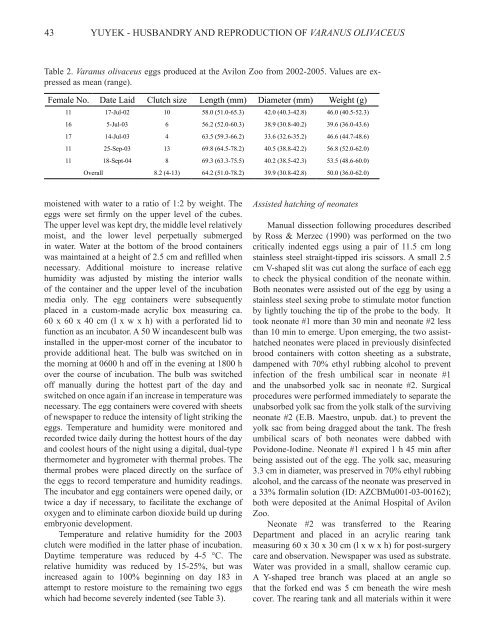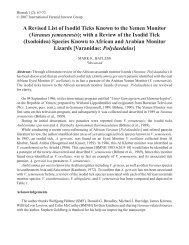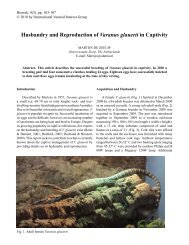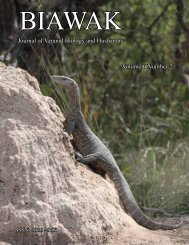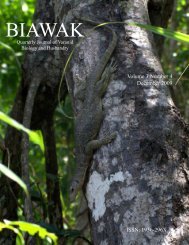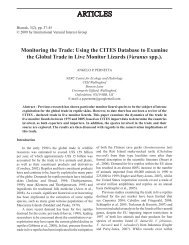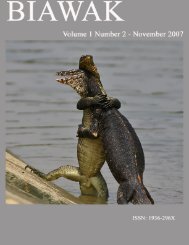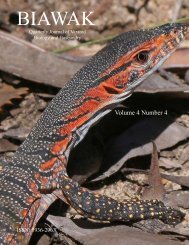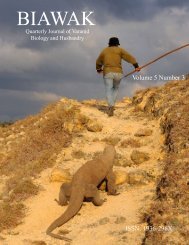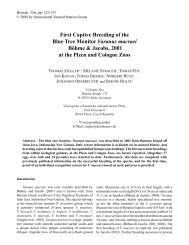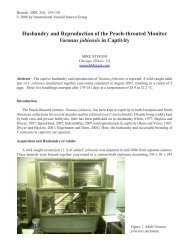Husbandry and Reproduction of Varanus olivaceus Hallowell ...
Husbandry and Reproduction of Varanus olivaceus Hallowell ...
Husbandry and Reproduction of Varanus olivaceus Hallowell ...
Create successful ePaper yourself
Turn your PDF publications into a flip-book with our unique Google optimized e-Paper software.
43YUYEK - HUSBANDRY AND REPRODUCTION OF VARANUS OLIVACEUSTable 2. <strong>Varanus</strong> <strong>olivaceus</strong> eggs produced at the Avilon Zoo from 2002-2005. Values are expressedas mean (range).Female No. Date Laid Clutch size Length (mm) Diameter (mm) Weight (g)11 17-Jul-02 10 58.0 (51.0-65.3) 42.0 (40.3-42.8) 46.0 (40.5-52.3)16 5-Jul-03 6 56.2 (52.0-60.3) 38.9 (30.8-40.2) 39.6 (36.0-43.6)17 14-Jul-03 4 63.5 (59.3-66.2) 33.6 (32.6-35.2) 46.6 (44.7-48.6)11 25-Sep-03 13 69.8 (64.5-78.2) 40.5 (38.8-42.2) 56.8 (52.0-62.0)11 18-Sept-04 8 69.3 (63.3-75.5) 40.2 (38.5-42.3) 53.5 (48.6-60.0)Overall 8.2 (4-13) 64.2 (51.0-78.2) 39.9 (30.8-42.8) 50.0 (36.0-62.0)moistened with water to a ratio <strong>of</strong> 1:2 by weight. Theeggs were set firmly on the upper level <strong>of</strong> the cubes.The upper level was kept dry, the middle level relativelymoist, <strong>and</strong> the lower level perpetually submergedin water. Water at the bottom <strong>of</strong> the brood containerswas maintained at a height <strong>of</strong> 2.5 cm <strong>and</strong> refilled whennecessary. Additional moisture to increase relativehumidity was adjusted by misting the interior walls<strong>of</strong> the container <strong>and</strong> the upper level <strong>of</strong> the incubationmedia only. The egg containers were subsequentlyplaced in a custom-made acrylic box measuring ca.60 x 60 x 40 cm (l x w x h) with a perforated lid t<strong>of</strong>unction as an incubator. A 50 W inc<strong>and</strong>escent bulb wasinstalled in the upper-most corner <strong>of</strong> the incubator toprovide additional heat. The bulb was switched on inthe morning at 0600 h <strong>and</strong> <strong>of</strong>f in the evening at 1800 hover the course <strong>of</strong> incubation. The bulb was switched<strong>of</strong>f manually during the hottest part <strong>of</strong> the day <strong>and</strong>switched on once again if an increase in temperature wasnecessary. The egg containers were covered with sheets<strong>of</strong> newspaper to reduce the intensity <strong>of</strong> light striking theeggs. Temperature <strong>and</strong> humidity were monitored <strong>and</strong>recorded twice daily during the hottest hours <strong>of</strong> the day<strong>and</strong> coolest hours <strong>of</strong> the night using a digital, dual-typethermometer <strong>and</strong> hygrometer with thermal probes. Thethermal probes were placed directly on the surface <strong>of</strong>the eggs to record temperature <strong>and</strong> humidity readings.The incubator <strong>and</strong> egg containers were opened daily, ortwice a day if necessary, to facilitate the exchange <strong>of</strong>oxygen <strong>and</strong> to eliminate carbon dioxide build up duringembryonic development.Temperature <strong>and</strong> relative humidity for the 2003clutch were modified in the latter phase <strong>of</strong> incubation.Daytime temperature was reduced by 4-5 °C. Therelative humidity was reduced by 15-25%, but wasincreased again to 100% beginning on day 183 inattempt to restore moisture to the remaining two eggswhich had become severely indented (see Table 3).Assisted hatching <strong>of</strong> neonatesManual dissection following procedures describedby Ross & Merzec (1990) was performed on the twocritically indented eggs using a pair <strong>of</strong> 11.5 cm longstainless steel straight-tipped iris scissors. A small 2.5cm V-shaped slit was cut along the surface <strong>of</strong> each eggto check the physical condition <strong>of</strong> the neonate within.Both neonates were assisted out <strong>of</strong> the egg by using astainless steel sexing probe to stimulate motor functionby lightly touching the tip <strong>of</strong> the probe to the body. Ittook neonate #1 more than 30 min <strong>and</strong> neonate #2 lessthan 10 min to emerge. Upon emerging, the two assisthatchedneonates were placed in previously disinfectedbrood containers with cotton sheeting as a substrate,dampened with 70% ethyl rubbing alcohol to preventinfection <strong>of</strong> the fresh umbilical scar in neonate #1<strong>and</strong> the unabsorbed yolk sac in neonate #2. Surgicalprocedures were performed immediately to separate theunabsorbed yolk sac from the yolk stalk <strong>of</strong> the survivingneonate #2 (E.B. Maestro, unpub. dat.) to prevent theyolk sac from being dragged about the tank. The freshumbilical scars <strong>of</strong> both neonates were dabbed withPovidone-Iodine. Neonate #1 expired 1 h 45 min afterbeing assisted out <strong>of</strong> the egg. The yolk sac, measuring3.3 cm in diameter, was preserved in 70% ethyl rubbingalcohol, <strong>and</strong> the carcass <strong>of</strong> the neonate was preserved ina 33% formalin solution (ID: AZCBMu001-03-00162);both were deposited at the Animal Hospital <strong>of</strong> AvilonZoo.Neonate #2 was transferred to the RearingDepartment <strong>and</strong> placed in an acrylic rearing tankmeasuring 60 x 30 x 30 cm (l x w x h) for post-surgerycare <strong>and</strong> observation. Newspaper was used as substrate.Water was provided in a small, shallow ceramic cup.A Y-shaped tree branch was placed at an angle sothat the forked end was 5 cm beneath the wire meshcover. The rearing tank <strong>and</strong> all materials within it were


